Alvedia Canine Quick Test DEA 1.1
This treatment applies to the following species:FOR BLOOD TYPING IN CATS AND DOGS
Following human surgical and medical advances, achieved partially to transfusion, recent progress in veterinary surgery and medicine is due to an effective and reliable Quick Test for blood typing.
Determining blood types represents an essential process in order to ensure animals benefit from transfusion support. There is a significant chance a dog or a cat will have a transfusion at least once, if not more in their lifetime. Basic blood typing is essential to perform these first, and potentially subsequent, transfusions as safely as possible.
That’s why academic centers have focused research on obtaining a better knowledge of blood typing in dogs and cats. Alvedia is proud to help the veterinary community to benefit from its latest project by putting at their disposal typing systems based on new monoclonal antibodies. These systems have been extensively tested, and are now used by veterinary universities and veterinary professionals.
BASIC IMMUNOHEMATOLOGY IN CATS AND DOGS
The Importance Of Blood Typing
Transfusion has taken an increasingly important role in the life support of canine and feline patients. Thus, the need for quick and accurate blood typing has now been recognized in order to assure safe and efficient transfusions.
It is now essential to perform blood typing to save animal lives in cases of; traumatic shock, surgical procedures, iron deficiency, spleen injury, severe bleeding after diseases and shock, some infectious diseases, hypoproteinemia, severe anemia and acute hemolysis syndrome.
Blood Groups In Cats And Dogs
In Cats
The only blood group system recognized is the AB system with the alleles A, B or AB. These alleles are highly immunogenic. The most common is the A group. There are breeds and geographic regions in which the percentage of B and AB groups is more represented. Recently, a new antigen has been described, the Mik antigen.
In Dogs
So far, there are more than a dozen blood groups described in dogs. The major and most immunogenic is DEA 1 (Dog Erythrocyte Antigen), for which a dog can be either positive or negative. Other blood groups include DEA 3, DEA 4, DEA 5, DEA 7 and recently, a new antigen has been discovered in some Dalmatians, the DAL antigen.
Blood Group Compatibility
In dogs, the determination of DEA 1 antigen is strongly recommended before any blood transfusion to avoid a potent alloantibody response against this antigen and to avoid acute hemolytic transfusion reaction.
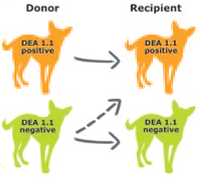
In cats, the presence of naturally occurring alloantibodies in type A and in type B cats requires that blood typing be performed prior to any blood transfusion to avoid acute hemolytic transfusion reaction, as well as in potential breeding situations to prevent neonatal isoerythrolysis.
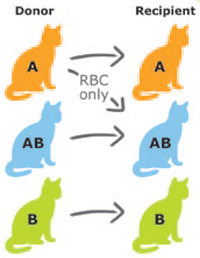
Haemolytic Disease (or Neonatal Isoerythrolysis) Of The Kitten
As type B cats have very strong naturally occurring anti-A alloantibodies, if a kitten of the A group receives alloantibodies through the colostrum from a B queen, these alloantibodies will provoke a serious life threatening reaction called hemolytic disease.
Quick Test Technology In Dogs
Quick Test Dea 1 For Determination Of Blood Group In Dogs
This test offers a very easy and reliable determination of a dog’s DEA 1 type status per unit or on short notice.
The system is based on the migration of red blood cells on a membrane, which has been specially treated, under the influence of a buffer flux moving along the membrane due to capillary action.
A monoclonal antibody specific to the DEA 1 antigen has been impregnated onto the membrane.
This antibody will retain positive DEA 1 red blood cells. It is characterized by the presence of a red band on the mid portion of this membrane (in front of “DEA 1” as written on the kit). If the test is negative, the line is not present.
The red control band, located on the upper part of the membrane (written “C” on the kit), has to appear, ensuring the test has run successfully. If not, the test must be repeated.
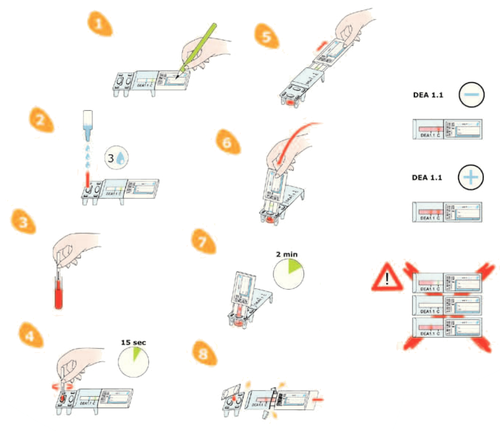
Interpretation of Results in Dogs

Dog with DEA 1 group

Dog without DEA 1 group
Quick Test Technology In Cats
Quick Test A+b For Determination Of Blood Group In Cats
This test offers a very easy and reliable determination of the cat’s A and/or B types per unit or on short notice.
The system is based on the migration of red blood cells on a membrane, which has been specially treated, under the influence of a buffer flux moving along the membrane due to capillary action.
Two monoclonal antibodies specific to the A and B antigens have been impregnated onto the membrane. These antibodies will retain positive A and/or B red blood cells. It is characterized by the presence of a red band on one or two portions of the strip.
If the red blood cells are of the A group, a red line will appear on the membrane, in front of the letter noted “A” on the kit. If the red blood cells are of the B group, a red line will appear on the membrane, in front of the letter noted “B” on the kit. If the red blood cells are of the AB group, two red lines will appear on the membrane, in front of the letters “A” and “B” on the kit.
The red control band, located on the upper part of the membrane (written “C” on the kit), has to appear, ensuring the test has run successfully. If not, the test must be repeated.
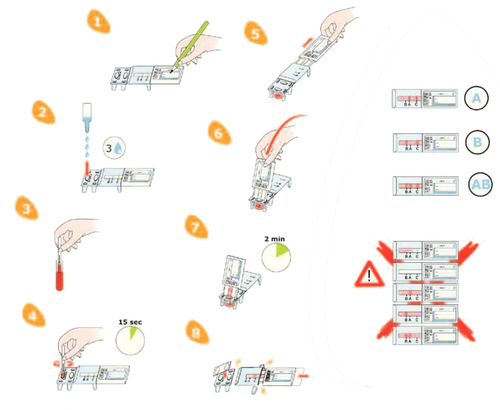
Interpretation of Results in Cats

Cat with A group

Cat with B group

Cat with AB group
ADVANTAGES OF OUR TECHNOLOGY
In cases of agglutination, the Quick Test will still be accurate.
Case of autoagglutination reaction in dogs:
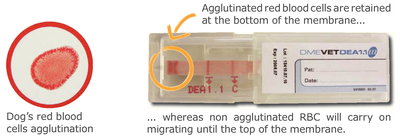
The animal can have an incredibly low PCV, and the Quick Test will still be accurate.
Case of anemia in cats: A group specimen
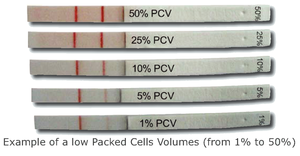
SCIENTIFIC INFORMATION
Comparison between the different blood typing methods
In dogs:
According to a recent publication of Pr Urs Giger et al., at Pennsylvania University, it was concluded that, “The results of GEL and CHROM (Alvedia) are most easy to interpret and archive.”
|
|
Sensitivity |
Specificity |
Positive Predictive Value |
Negative Predictive Value |
Accuracy |
|
|
GEL (LAB technique) |
100% |
100% |
100% |
100% |
100% |
|
|
CHROM (Alvedia) |
88% |
100% |
100% |
88% |
93% |
|
|
CARD |
(≥ 1+) |
100% |
75% |
82% |
100% |
89% |
|
(≥ 2+) |
94% |
88% |
90% |
92% |
91% |
|
In cats:
According to a recent publication of Pr Urs Giger et al., at Pennsylvania University, it was concluded that, “[...] currently available commercial laboratory and in-clinic techniques generally provide accurate typing results. The GEL and CHROM (Alvedia) methods made interpretation of results simple.”
Quick Test Extras
A Permanent Record
With each test, Alvedia provides a blood typing card to be given to the owner of the animal, and a blood typing form to be affixed in the medical record of the animal.
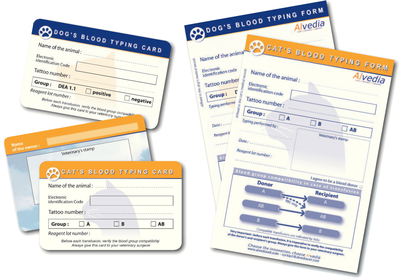
Alvedia
Alice Veterinary Diagostic
To Place an Order:
Contact
ANIMAL BLOOD RESOURCES INTERNATIONAL
Phone: (800)-243-5759
www.abrint.net
P. O. BOX 1118, Dixon, CA 95620
CPN: 13980112
P.O. BOX 609, STOCKBRIDGE, MI, 49285
| Telephone: | 800-2HELPK9 (800-243-5759) | |
| Fax: | 517-851-7762 | |
| Website: | www.ABRInt.net | |
| Email: | customerservice@ABRInt.net |
 |
THIS SERVICE AND DATA ARE PROVIDED "AS IS". DVMetrics assumes no liability, and each user assumes full risk, responsibility, and liability, related to its use of the DVMetrics service and data. See the Terms of Use for further details. |

Copyright © 2025 Animalytix LLC. Updated: 2025-08-27
